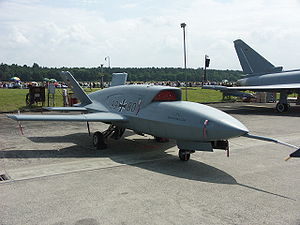|
EADS Barracuda
The EADS Barracuda was a jet powered unmanned aerial vehicle (UAV), EADS, used for the role of aerial reconnaissance and also combat (like UCAV).[1] The aircraft was a joint venture between Germany and Spain. Development of the project was stopped after the first prototype crashed at Mar Menor while approaching for landing during a test flight.[2] The program was resumed in 2008, with a second prototype being completed in November 2008. The rebuilt Barracuda underwent a series of successful flight tests in Goose Bay, Canada during July 2009,[3] followed by further flight campaigns in 2010[4] and 2012.[5] The Barracuda's primary competition was Dassault nEUROn for strategic and defensive contracts. Both were stealthy and had a maximum air speed of around Mach 0.85. While Germany and Spain were behind the Barracuda, France, Italy, Sweden, Switzerland, Greece, and Spain as well funded the nEUROn.[6] It had an operating ceiling of around 20,000 ft (6,096 m) and carried a maximum payload of 300 kg.[7] It was retired after six test campaigns. Development The Barracuda originated as a UAV design study, intended to push EADS into the market for medium-altitude long-range UAVs, a market they viewed as dominated by the United States and Israel.[8] Its development initially began in 2003 in secrecy. It was financed by Airbus, along with support from the German Federal Ministry of Defense, the German Procurement agency BAAINBw, and the Wehrtechnische Dienststellen.[9] Its official debut took place at the 2006 International Aerospace Exhibition, where military applications and specifications for the Barracuda were revealed.[10] The Barracuda crashed in Mar Menor at Region de Murcia during a 2006 test flight, which put the project on hold until 2008. They also planned to develop the Barracuda as a modular platform, so that it could be refitted for various roles like maritime patrol.[11] Offensive capabilities were not planned, but it could carry weapons if customers expressed interest for it. The Barracuda could also be capable of carrying weapon systems. The systems could be installed in the central payload bay. Germany also discussed a partnership with Sweden and Italy for a multinational unmanned aerial vehicle effort in order to compete with the French-led Dassault nEUROn programme.[12] Spain, Italy and Sweden were already participants in the French-led effort.[13] Design
The Barracuda was based on commercially available 'off the shelf' components, but also many refined systems.[10] Its fuselage was constructed entirely from carbon fibre,[6] but also had a greater strength to weight ratio than traditional aircraft materials such as aluminum (the structure of the Eurofighter Typhoon and Boeing 787 Dreamliner were also made significantly out of it).[10] The only significant metal component was the wing spar, running through the middle and reinforcing the wings. The wing spar allowed for easy removal of the wings for transportation. The Barracuda used a specially shaped fuselage, including S-duct air inlet and V-tail, to scatter deflected radar, rendering the UCAV as a stealth drone.[6] The payload was to be mostly for reconnaissance and observational purposes, including an Emitter Location System (ELS) , a Synthetic Aperture Radar (SAR), and an array of Electro-Optical Sensors.[7] After its retirement, its technology is said to be repurposed in the Eurodrone, and the Future Combat Air System. [9] SpecificationsData from [7] General characteristics
Performance
See alsoAircraft of comparable role, configuration, and era
References
Sources
External links |
||||||||||||||||||
